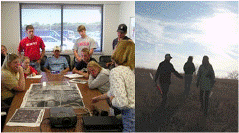Environmental Studies Program
Date of this Version
Fall 12-2010
Abstract
This is a case study involving three elementary schools in the greater Lincoln, Nebraska area. These schools were chosen to provide insight to three different economic backgrounds. Saratoga and Randolph from Lincoln Public Schools, and Norris Elementary part of Norris Public Schools 160 was the third school involved in the study. This case study focused on seeing whether socio/economic background had any effect on environmental awareness. To do so, surveys were handed out to each school to help measure environmental awareness. These surveys also helped determine where the environmental literacy standards were in the elementary schools of Lincoln, Nebraska. The hypothesis of this case study is lower socio/economic background will result in schools having lower environmental awareness.
At all three schools, there were no-till, raised bed gardens. No herbicide was used and all vegetables grown were 100% organic. Along with the garden preparation, college students also taught the elementary school children, important environmentally friendly practices. The results of the overall surveys consisted of the following: the majority of the elementary children gained most of their environmental knowledge from school and teachers. Whose environmental vocabulary and jargon was unfamiliar to the students surveyed. There is a growing trend of children spending more time indoors than outdoors. The elementary children are most comfortable with the word, “Outdoors”. Individually, Saratoga saw the highest percentage of correct answers. Saratoga was also had the most impoverished socio/economic background. Randolph had the second most percentage of correct answers. Randolph also was the second tier up on this reports socio/economic scale. Norris had the lowest percentage of correct answers. Norris was the highest school on this reports socio/economic scale. These results were inversely related to the hypothesis, which stated, if a school with a lower socio/economic scale would have lower environmental awareness.
Included in
Curriculum and Instruction Commons, Curriculum and Social Inquiry Commons, Educational Assessment, Evaluation, and Research Commons, Environmental Sciences Commons, Other Education Commons, Science and Technology Studies Commons


Comments
AN UNDERGRADUATE THESIS Presented to the Faculty of The Environmental Studies Program at the University of Nebraska-Lincoln In Partial Fulfillment of Requirements For the Degree of Bachelor of Arts, Major: Environmental Studies, With the Emphasis of: Natural Resources; 12/04/2010
Copyright 2010 Grady Cooper Erickson